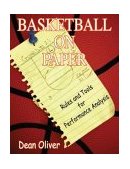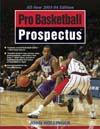Book Reviews:
Basketball on Paper & Pro Basketball Prospectus
Moneyball was a fine book that detailed the success of the Oakland A's using a new methodology for evaluating baseball talent. There can be little doubt that it has spurred significant changes in how several MLB teams are operated, with the influence of Billy Beane and the "Bill James" sabermetricians becoming more widespread with the subsequent hiring of like minded GM's in Boston, Toronto, Los Angeles...
Also of interest is that shortly after the book hit the market, coaches and executives of teams in other sports took notice. The NFL and NBA in particular are becoming more serious about trying to lead their respective leagues into the new era of sports statistics, and the relevance of new objective tools for measuring talent is moving forward substantially. As they say, Money(ball) changes everything.
There have been two books published during the past few months that should be on the book shelf of every serious student of the NBA game. One approaches basketball with an eye on theory, the other puts a lot of emphasis on rating the current crop of pro hoops players. As such they are complementary, with much to be learned from both works.
 Dean Oliver's Basketball On Paper aims to lay out new measures for examining team and player performance and must be considered the finest effort in this regard yet seen for basketball. From his pioneering work in charting games at a touch level, to his endeavors with the WNBA in tracking individual defensive performance, Oliver has taken bold steps that may well revolutionize decision making at both the coaching and personnel management levels in the coming years.
Dean Oliver's Basketball On Paper aims to lay out new measures for examining team and player performance and must be considered the finest effort in this regard yet seen for basketball. From his pioneering work in charting games at a touch level, to his endeavors with the WNBA in tracking individual defensive performance, Oliver has taken bold steps that may well revolutionize decision making at both the coaching and personnel management levels in the coming years.
While there is some addressing of historical matters (which were the best and worst offensive and defensive teams, a look at some of the more famous players of the NBA), and substantial focus on his innovative player tools (including such things as "floor percentage", offensive and defensive ratings, won-lost player records, and "Basketball's bell curve"), there are also chapters devoted to sometimes spectacular research ideas (a case in point being a look at the effect of a "bad referee" on the outcome of a game).
Often humorous in tone, the book is undoubtedly geared to a serious and knowledgeable basketball audience, and by all accounts can already be found on the bedside tables of many an NBA GM, Coach and Scout.
Overall it is easy to issue a Highly recommended proclamation. For more information on the book, visit the official Basketball On Paper web site.
 There have been several attempts at producing the definitive "annual" for the NBA, from the Zander Hollander "Pro Basketball Handbooks" to the Rick Barry/Jordan Cohn "Pro Basketball Bibles." John Hollinger's Pro Basketball Prospectus (2003-04 edition) fills the void nicely, and undertakes the daunting task of providing innovative statistical ratings and commentary for all of the current pro ballers.
There have been several attempts at producing the definitive "annual" for the NBA, from the Zander Hollander "Pro Basketball Handbooks" to the Rick Barry/Jordan Cohn "Pro Basketball Bibles." John Hollinger's Pro Basketball Prospectus (2003-04 edition) fills the void nicely, and undertakes the daunting task of providing innovative statistical ratings and commentary for all of the current pro ballers.
Hollinger does not shy away from making critical comments ("11 reasons why Sprewell is over-rated") or handing out praise (cover boy Michael Redd was pronounced as the "biggest bargain in the league" long before the season tip-off), and has a keen eye for the skills and deficiencies in players through countless hours of actually watching the games. [Recently he boasted of being perhaps the only person not directly affiliated with the Hawks to have seen every Atlanta game of the 2003-04 campaign!]
Along with his astute observations, he refers to key statistical measures he has created, including his comprehensive and complicated PER rating (a variant of which we use on this site for the "By Position" stats), and possession-based evaluations that are similar to those in vogue with most of the serious NBA number crunchers. Covering the 400+ players in substantial detail does not allow for a lot of space to be devoted to "asides" but there is some reflection on "Similarity Scores" as a tool for predicting young player performance growth, and the "Fluke Rule" that casts a skeptical eye on an older player who has posted a career year.
This work is also highly recommended by us here at 82games, and more information on the book as well as additional articles can be found on Hollinger's web site at AlleyOop.com
|

